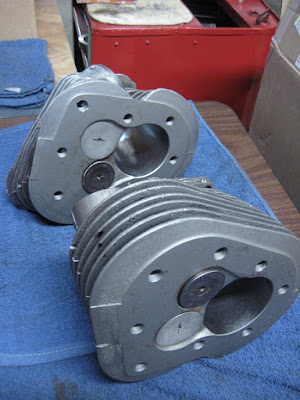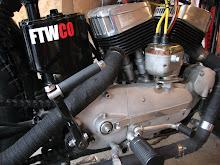The 1948 WR is one of the only years this racing model has a vertically mounted magneto (like a Sportster) and a generator block-off plate. The valves are "at angles" in the cylinders, tipped towards the bore. The tappet block bores are angled. The tappet blocks themselves are straight. The small feet on the tappets are angled, and made specific for each cam - the cam lobes are straight. Confused?
I bored these cylinders for the pop-up style pistons. Intake valves and seats are ground at 30 degrees for improved flow (I heard the Indian factory did this too) I ground the exhaust valves and seats at 45 degrees for longer life. Big ports on the WR cylinders !
Ball bearings are used where applicable for the cams. 4 each in the case, 2 each in the gear cove. All the cam shafts must be polished down for a perfect hand-fit (slip fit) into the center of the ball bearings. You don't want a press fit. The OD of the ball bearings are medium press fit into the case and gear cover. I have some special set-up bearings I use that are easily removed for setting the cam end play with special shims I came up with, that are installed behind the ball bearings. These motors take a lot of time. Hours and hours of fitting, spinning and measuring to get it right !
Here's the little "feet" solid cam followers these WRs ran . . . The long feet face-each-other and are site specific for each camshaft. The tappet blocks have no threads for covers. There's an o-ring groove around the top of each tappet, and a set screw to hold the cover. The lower cover just slides over the o-ring - and a hole in the side of the lower cover secures the cover to the tappet block with that small screw. Now I'm confused.
I'll bead blast the tappet blocks and paint them original, Hi-Heat H-D Silver.
Subscribe to:
Post Comments (Atom)


















No comments:
Post a Comment